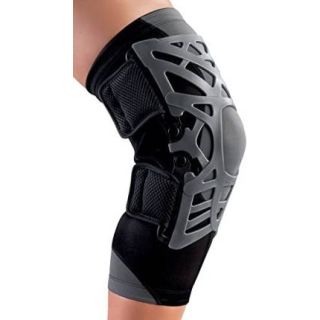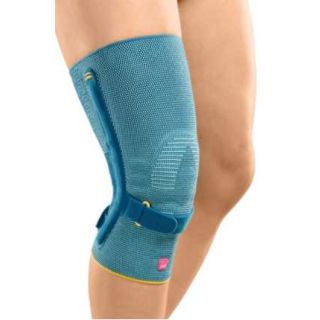Osgood-Schlatter Disease
What Is Osgood Schlatters Disease?
Osgood Schlatters disease is a painful enlargement of the bump of the shin bone (tibia) just below the knee. This bump is called the tibial tuberosity. The tendon from the kneecap (patella) inserts here. Osgood-Schlatters disease is most often seen in children between the ages of 10 and 15 and usually appears during a period of rapid growth.
How Does It Occur?
Osgood Schlatters disease is caused by overuse of the knee in normal childhood and sporting activities. It is possible that muscles are too tight in the front of the thigh, the back of the thigh, or in the calf.
What Are The Symptoms Of Osgood Schlatters Disease?
Your child will complain of a painful bump below the kneecap. The parents or child may notice a bony enlargement at the top of the shin bone.
How Is Osgood Schlatters Disease Diagnosed?
Your child's doctor will do a physical examination of the knee and review your child's symptoms. X-rays show an enlarged tibial tuberosity. An x-ray may also show irregular or loose bony fragments from the tibial tuberosity.
How Is It Treated?
Your child may need to rest or do activities that do not cause knee pain. Ice packs should be applied to the knee for 20 to 30 minutes every 3 to 4 hours for 2 to 3 days or until the pain goes away. If the knee is swollen, it should be elevated by placing a pillow under it. Your child's doctor may recommend a knee brace for activity. The doctor may prescribe anti-inflammatory medication and may recommend exercises.
Click here for our entire line of knee braces for Osgood-Schlatter.
When Can My Child Return To His Or Her Sport Or Activity?
The goal of rehabilitation is to return your child to his or her sport or activity as soon as is safely possible. If your child returns too soon the injury may worsen, which could lead to permanent damage. Everyone recovers from injury at a different rate. Return to his or her sport or activity will be determined by how soon your child's knee recovers, not by how many days or weeks it has been since the injury occurred. In general, the longer your child has symptoms before starting treatment, the longer it will take to get better.
Your child may safely return to his or her sport or activity when, starting from the top of the list and progressing to the end, each of the following is true:
1. Your child's tibial tuberosity is no longer tender.
2. The injured knee can be fully straightened and bent without pain.
3. The knee and leg have regained normal strength compared to the uninjured knee and leg.
4. Your child is able to jog straight ahead without limping.
5. Your child is able to do 45-degree cuts.
6. Your child is able to do 90-degree cuts.
7. Your child is able to do 20-yard figure-of-eight runs.
8. Your child is able to do 10-yard figure-of-eight runs.
9. Your child is able to jump on both leg without pain and jump on the injured leg without pain.
How Can Osgood-Schlatters Disease Be Prevented?
Osgood-Schlatters disease may be difficult to prevent. The most important thing to do is to have your child limit activitiy as soon as he or she notices the painful bump on the top of the shin bone. Proper warm-up and stretching exercises or the thigh, hamstring, and calf muscles may help prevent Osgood-Schlatter disease.
Osgood-Schlatters Disease Rehabilitation Exercises:
You can start stretching the muscles in the back of your leg using exercises 1 and 2 right away. When you have only a little discomfort in the upper part of your leg bone (tibia), you can do exercises 3, 4, and 5.
1. Hamstring stretch: Lie on your back with your buttocks close to a door-way and extend your legs straight out in front of you along the floor. Raise your injured leg and rest it against the wall next to the door frame. Hold this position for 30 to 60 seconds. You will feel a stretch in the back of your thigh. Repeat 3 times.
2. Calf stretch: Face a wall and put your hands against the wall at about eye level. Keep the injured leg back, the uninjured leg forward, and the heel of your injured leg slightly inward (as if you were pigeon-toed) as you slowly lean into the wall until you feel a stretch in the back of your calf. Hold for 30 seconds. Repeat 3 times.
3. Quadriceps stretch: Stand an arm's length away from a wall, facing straight ahead. Brace yourself by keeping the hand on the uninjured side against the wall. With your other hand, grasp the ankle of the injured leg and pull your heel up toward your buttocks. Don't arch or twist your back. Hold this position for 30 seconds. Repeat 3 times.
4. Straight leg raise: Sit on the floor with the injured leg straight and the other leg bent with your foot flat on the floor. Move the toes of your injured leg toward you as far as you can, while pressing the back of your knee down and tightening the muscles on the top of your thigh. Raise your leg 6 to 8 inches off the floor and hold for 5 seconds. Slowly lower it back to the floor. Repeat 10 times. Do 3 sets of 10.
5. Prone hip extension: Lie on your stomach. Squeeze your buttocks together and raise your injured leg 5 to 8 inches off the floor. Keep your back straight. Hold your leg up for 5 seconds and then lower it. Repeat 10 times. Do 3 sets of 10.
All material provided is designed for information purposes only and should not be used to replace the care of a health care professional. Do not rely on any of the information for diagnosis or treatment. It is recommended that you visit a qualified health care professional for individual and personal attention.


